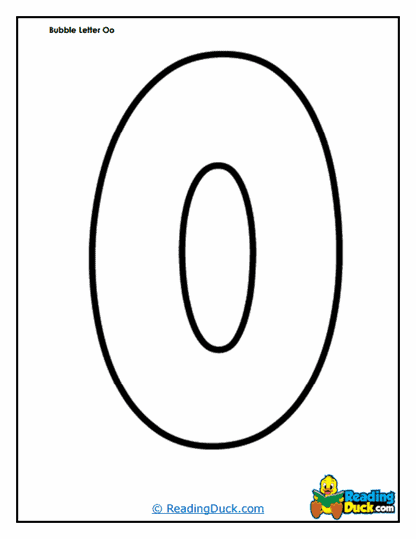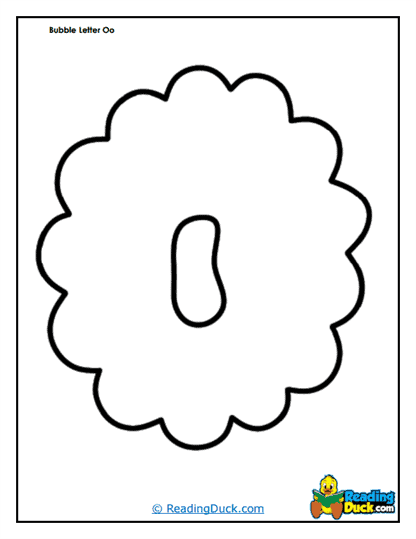Bubble Letter Oo Worksheets
About Our Bubble Letter Oo Worksheets
Bubble letter "Oo" worksheets are a dynamic and engaging resource designed to support the early education of young children. These worksheets use visually captivating, large, and bold bubble letters to draw attention while integrating educational activities that focus on literacy, creativity, and fine motor skill development. The playful nature of the worksheets ensures that children remain engaged and excited about learning, while the structured activities provide essential practice in foundational skills. Regular use of these worksheets not only reinforces letter recognition and phonemic awareness but also helps instill confidence in young learners. Their versatility makes them an excellent tool for use in classrooms, homeschooling, or casual learning at home, making them a favorite among educators and parents alike.
1. Fine Motor Skill Development
They are invaluable for enhancing fine motor skills, as they require children to engage in activities like tracing and coloring. By carefully tracing the outlines of the bubble letters, kids develop hand-eye coordination and strengthen the small muscles in their hands, which are crucial for writing. Coloring within the lines further refines their pencil grip and control, laying the groundwork for more advanced tasks like forming letters independently. Many worksheets also incorporate cutting and pasting activities, where children cut out shapes or letters and glue them onto the worksheet. These additional tasks improve dexterity and precision, providing comprehensive motor skill practice that extends beyond writing. Over time, these activities prepare children not only for academic success but also for practical tasks requiring fine motor coordination, such as tying shoes or using scissors.
2. Letter Recognition and Formation
The large, bold format of the sheets is intentionally designed to make the letter visually memorable for young learners. The oversized letters help children focus on the distinct shapes of both uppercase "O" and lowercase "o," which is essential for distinguishing them from similar shapes like "Q" or "0." Repetition plays a key role in solidifying recognition; by frequently tracing, coloring, and interacting with the letter "Oo," children internalize its form and learn to replicate it with increasing accuracy. This consistent practice also helps children connect the physical act of writing the letter with the phonetic sound it represents, reinforcing the critical link between written and spoken language. For beginners, these activities provide a supportive introduction to the alphabet, while more advanced learners can use them as a stepping stone to forming words and sentences.
3. Phonemic Awareness
This series often integrates activities that build phonemic awareness by associating the letter "O" with its corresponding sound. Worksheets might feature pictures of objects like "orange," "octopus," or "owl," encouraging children to identify the letter's sound in words and recognize its role in language. This connection between the letter's visual form and its phonetic sound lays the foundation for reading and phonics skills, as children learn to decode and construct words. By repeatedly seeing and hearing the letter "O" in different contexts, young learners develop a stronger understanding of how letters function within words. The inclusion of rhyming activities or sound-matching games in these worksheets can further enhance their ability to distinguish and manipulate sounds, which is a critical precursor to fluent reading.
4. Encourages Creativity
Bubble letter worksheets allow for creative exploration, making learning more enjoyable and personalized for each child. Children can decorate the bubble letters with patterns, stickers, or unique color schemes, transforming the activity into an opportunity for self-expression. This creative aspect keeps kids engaged and helps them take ownership of their learning, as they see their personal style reflected in their work. Teachers and parents can also enhance the experience by incorporating thematic elements, such as creating worksheets centered around animals, seasons, or holidays, to make the activity even more exciting. The blend of education and creativity fosters a love for learning while keeping children motivated to complete the tasks. This balance of structure and freedom ensures that children associate educational activities with fun, setting the stage for lifelong curiosity and exploration.
5. Confidence Building
Successfully completing this series of worksheets gives children a sense of achievement, which is critical for building their confidence in early literacy skills. The simple yet rewarding nature of tracing and coloring helps children feel capable and competent, boosting their self-esteem. Each completed worksheet becomes a tangible reminder of their progress, reinforcing their belief in their ability to recognize and write letters. The playful design of the bubble letters creates a non-threatening learning environment, alleviating any anxiety they might feel about making mistakes. Over time, this positive reinforcement encourages a growth mindset, where children view challenges as opportunities to improve rather than obstacles to fear. This confidence extends beyond literacy, empowering them to approach new learning experiences with enthusiasm and determination.
Tips for Using Bubble Letter Worksheets
Pair the Activity with Verbal Practice
To maximize the educational benefits, combine the visual and tactile aspects of the worksheet with verbal practice. For instance, encourage children to say the name and sound of the letter "N" each time they color or trace it. This multi-sensory approach reinforces their memory by engaging multiple areas of the brain, making the learning experience more comprehensive. Verbal repetition also helps children internalize the sound-letter association, which is a crucial step toward phonics mastery. Additionally, this practice allows adults to correct any mispronunciations and provide immediate feedback, ensuring children develop accurate language skills from the start.
Encourage Creative Use of Colors
Using a variety of colors can make the activity more exciting and memorable for children. You might suggest that they use one color for the uppercase "N" and another for the lowercase "n," helping them visually differentiate between the two. Alternatively, children can create patterns, such as stripes or polka dots, to personalize their worksheets and make the activity more engaging. This creative freedom not only enhances the child's enjoyment but also encourages them to take pride in their work. These colorful creations can then be used as visual aids for future lessons, reinforcing their learning in a fun and interactive way.









